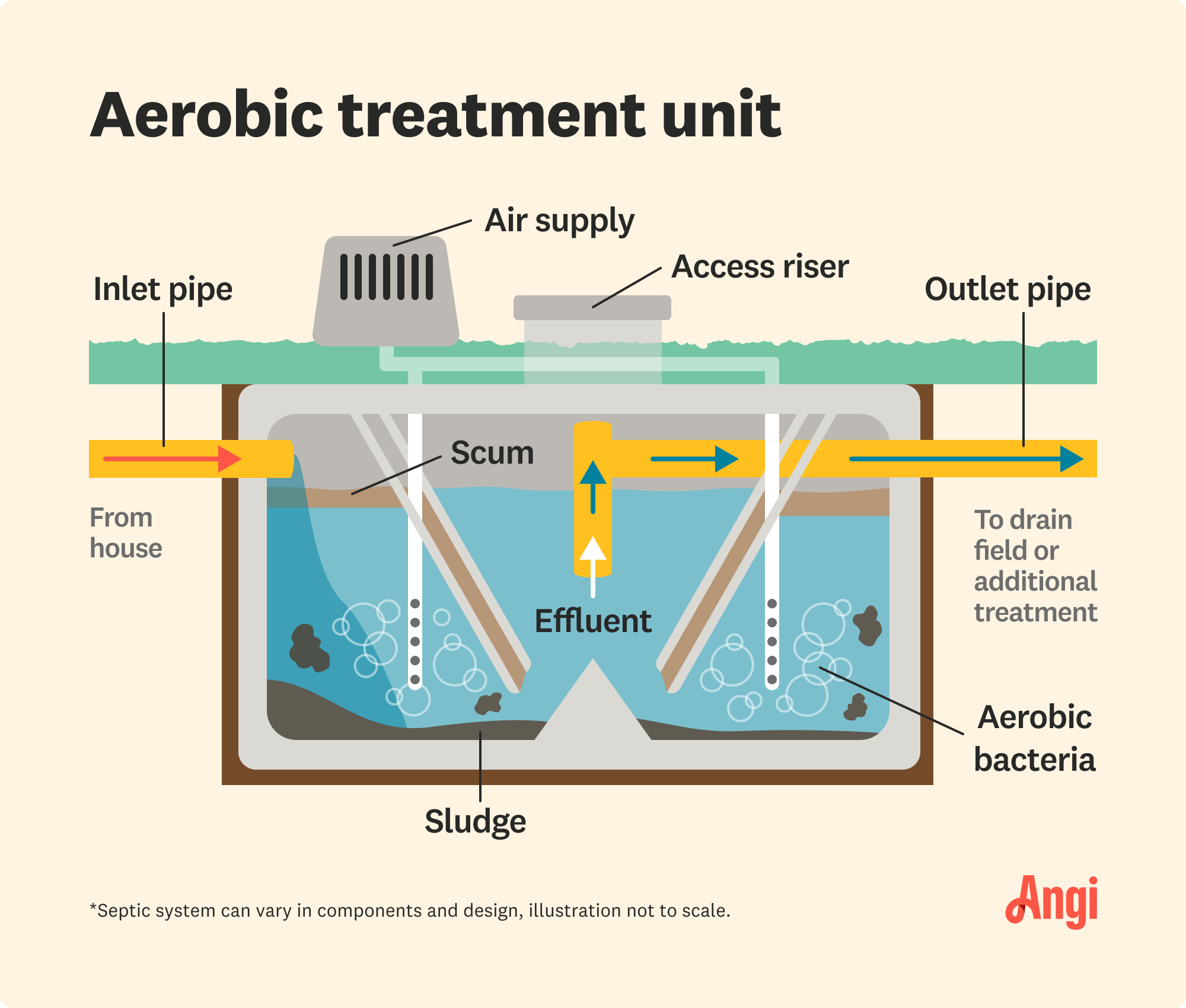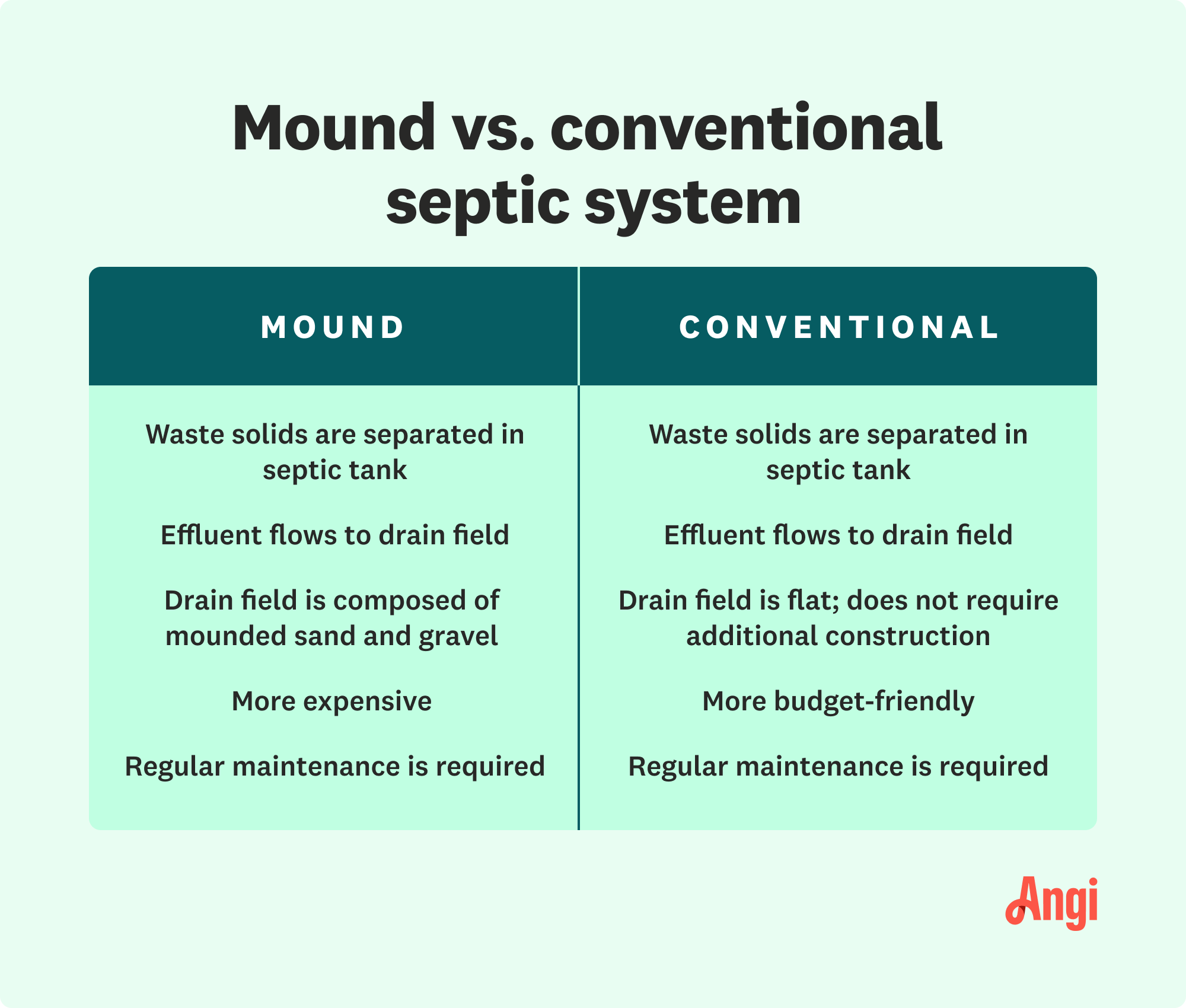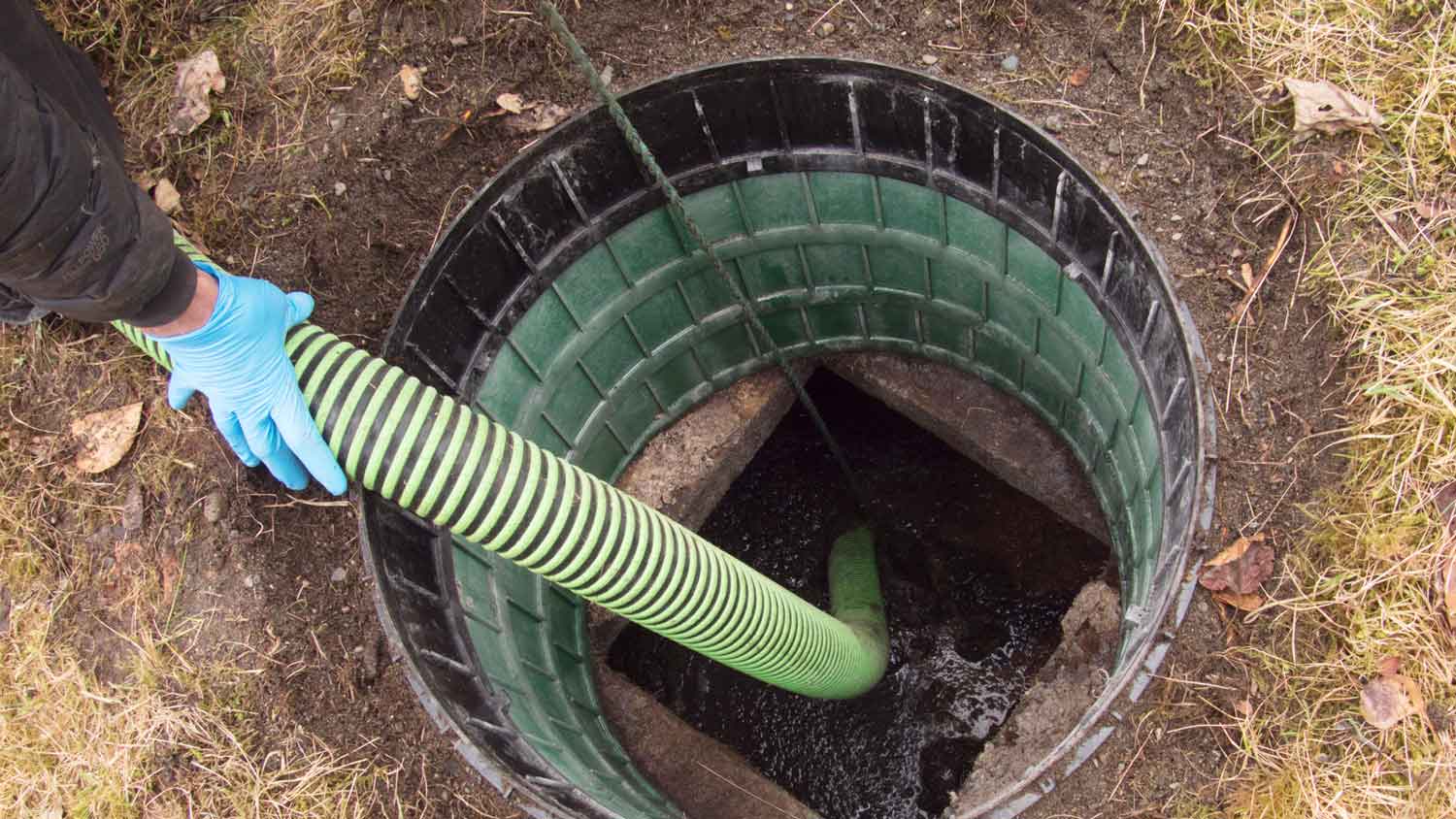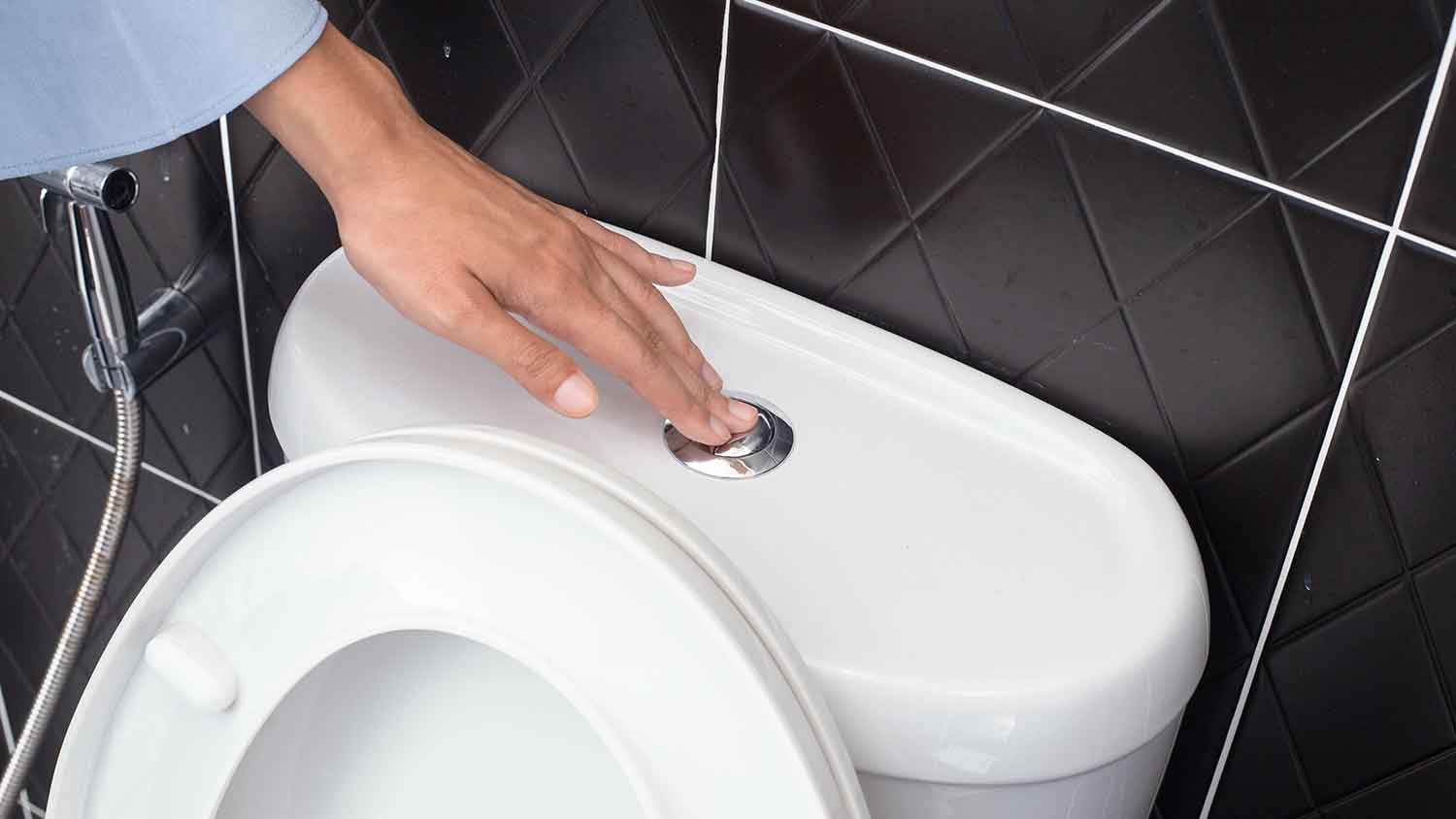
Need to know what sewer line replacement costs in Atlanta, GA? This guide will help you prepare to budget for sewer line replacement done by local contractors.
Is the mound system a match for your home?


Mound septic systems are used when a landscape is not well suited to a conventional septic system drain field.
Mound septic systems work very similarly to conventional ones.
These systems can cost slightly more than conventional systems to install: $10,000 to $20,000 on average.
Mound systems require occasional maintenance, including periodically pumping the septic tank.
A typical septic system is made up of two main components: a septic tank and a drain field. But some landscapes—like those with shallow bedrock or soil depth or high groundwater—aren’t suited for a traditional drain field. In these instances, additional ground material is built up into a mound in order to allow for more filtration and treatment of wastewater before it returns to the aquifer. Thus, a mound septic system is born.
But how exactly does this process work, and is a mound septic system right for your home?

In the septic tank, waste is separated into three layers:
Scum contains lighter solids like grease and fat and floats on top of the water’s surface.
Effluent is the cleanest layer of wastewater, or what’s left over after solid waste separates.
Sludge is composed of the heavier solids (including human waste) that fall to the bottom of the tank.
A mound septic system works mostly the same way as a traditional septic system does: Wastewater from your home first enters a septic tank, where solid waste is separated from liquid waste. From there, the cleanest wastewater, or effluent, enters a pump chamber, which pumps the effluent into the drain field—in this case, a sand- and gravel-filled mound—in controlled doses so that it doesn’t flood the area. As the effluent filters through the gravel and sand that make up the mound, bacteria work to further cleanse it before it returns to the soil and groundwater.
The main difference between a mound septic system and a traditional septic system is that the drain field has been built up into a mound that’s filled with specific types of gravel and sand in order to aid in this process. Again, the mound is usually used because the natural landscape doesn’t offer enough room or the right kind of soil for this treatment process to occur without the addition of the mound.

While a mound septic system can be an effective and low-cost way to treat your wastewater without being connected to a city sewer system, you can’t just set it and forget it. Like other types of septic systems, sand mound septic systems do require maintenance and repairs in order to keep functioning properly.
For starters, your mound septic tank will need to be pumped from time to time in order to get rid of the sludge that builds up on the bottom. Generally, septic tanks must be pumped approximately once every three to five years, although your specific experience will vary depending on how much water you use, how many people live in your home, the size of your tank, and other factors. The cost of a one-time septic tank pump is about $400, or $0.30 per gallon.
Additionally, the components of the mound septic system itself require maintenance and upkeep. The pump in your pump chamber will eventually wear out and need to be replaced, for example, and the outlet pipe that leads from your septic tank to your drain field can become clogged without installing (or replacing) an effluent filter or pump screen.
According to data from Angi customers, most homeowners (32.9%) have a pro clean their septic tank every one to four years. However, 24.5% of homeowners don’t know how often they get their septic tank cleaned. Keep in mind that this data is for general septic tank cleaning—not for one specific system. If you don’t know the last time you got your system cleaned, reach out to a septic company ASAP.
While you can flush normal paper products and waste into your mound septic system, it’s important to avoid flushing other objects, like cigarette butts, feminine hygiene products, paper towels, and diapers. Even with toilet paper, it’s important not to flush too much all at once. Some other maintenance tips include:
Conserving water when possible, to minimize load on the system.
Directing roof runoff and sump pump discharge away from the mound to keep it from getting saturated.
Only putting shallow-rooted grass over the mound and mowing it regularly.
Regularly inspecting for cracks and erosion.
Hiring a local septic pro to repair any damage as soon as possible.
Never parking over the mound or planting trees or shrubs.
Avoid dumping harsh household chemicals over the mound.
Baby wipes and other “flushable” bathroom wipes are often not able to properly break down in your septic system. Avoid flushing any wipes down the toilet, even if they say “flushable.”
Finally, you should plan and protect a replacement area for the mound itself in the event that the working mound needs repairs or an addition to function properly. Septic tanks must be located at least 5 feet away from your home, while the mound will usually be at least 10 or 20 feet away.

While maintaining a mound septic system is relatively low-cost, and the system can last about 20 to 25 years on average when properly maintained, there is a substantial upfront cost to installing a mound septic system.
A mound septic system can cost about $10,000 to $20,000 on average to install and set up, and because the mound requires additional construction, they’re often more expensive than traditional septic systems to get started.
Like any home improvement decision, installing a mound septic system has both benefits and drawbacks to consider. Here are a few of them:
Pros
Provides a way to treat your own wastewater without being connected to a city sewer system, even if you live in an area with a high water table.
Relatively inexpensive to maintain, given its long average lifespan.
Usable in almost any climate.
Cons
You need enough space to construct a mound and also reserve a replacement area.
There can be odors associated with a mound septic system under certain circumstances, though this should be infrequent if the system is maintained properly.
Much more expensive upfront costs.
From average costs to expert advice, get all the answers you need to get your job done.

Need to know what sewer line replacement costs in Atlanta, GA? This guide will help you prepare to budget for sewer line replacement done by local contractors.

Replacing a drain field requires digging up quite a bit of land and involves a decent amount of testing. Using this guide, you’ll learn how much it costs to replace a drain field based on a few key factors such as size and type of septic system.

Need to know what sewer line replacement costs in Philadelphia, PA? This guide will help you prepare to budget for sewer line replacement done by local contractors.

Odor problems in the laundry room? We discuss why your washing machine smells like sewage and how to fix those stinky plumbing issues.

Your lot might require an alternative septic system based on location and soil conditions. Learn all about alternative septic systems and their costs.

Follow this guide to learn how to get rid of a cesspool to save some money and transform your home into a more eco-friendly space.